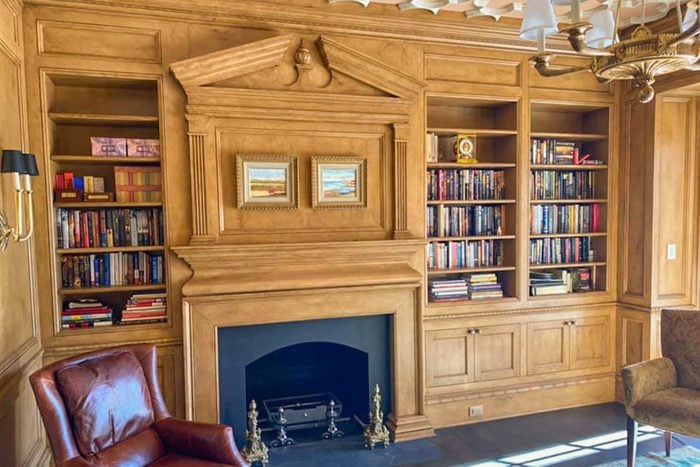Is There a Way To Paint Something So It Looks Like Wood?
Updated: Nov. 15, 2023

Create a wood-like appearance on any surface with the art of faux finishing.
With the right products and techniques, you can use paint to create the look of wood on any surface. It requires multiple layers of paint or glaze, as well as special tools.
We spoke to industry experts Chris Burke, a professional faux finish painter, and Frank Campanelli, owner of a full-service painting company. They offered tips, tricks and product recommendations to help DIYers achieve great results.
On This Page
What Surfaces Can Be Painted To Look Like Wood?
Drywall, plaster, metal, concrete, medium density fiberboard (MDF) and plastic can all be painted to look like wood. Different materials may require different kinds of surface prep.
Use the Best Paint
Water-based acrylic paints are the go-to option for pros and DIYers alike. Fusion Mineral Paint, a 100% industrial-grade acrylic resin paint, is a favorite among DIYers, especially on furniture. It comes in various colors, features a durable matte finish and comes with a built-in topcoat.
Pros like Burke and Campanelli thin their paint with additives to create a glaze. “You put an agent in the paint that slows down the drying time, so you can work with it longer,” Campanelli says. “It makes the paint thinner, but still adds color.” Burke likes the Golden Artist Colors’ Open line for the same reasons.
When choosing colors, begin by determining which wood species you would like to emulate. Burke recommends finding examples online, then identifying the colors that exist in that piece to determine yours. The lightest tone will be your base coat, with any darker tones layered on top.
“A lot of times I’ll use Van Dyke Brown or Raw Umber or Burnt Umber and mix that in the glaze for the topcoat,” Burke says. “I’ll put these over a lighter base.”
How To Create a Wood Look With Paint
“Whether you’re doing oak or walnut or mahogany, it’s usually a four-layer process,” Burke says, “Then a clear topcoat.” Make sure to let each paint layer dry thoroughly before adding the next to avoid mixing colors.
- Prep: Start with a clean, smooth and properly primed surface.
- Base coat: Apply your lightest paint or glaze color to the entire surface with a brush. Like the primer, keep brush strokes in the same pattern and direction as you want the final look.
- Flogging coat: Flogging is a brush technique that creates a speckled texture in the coating, mimicking wood pores in real wood surfaces. “You put your glaze coating on with a regular brush, then slap it lightly with the sides of a three-inch or two-inch brush to make little tic marks in the background,” Burke says. If using paint, apply a thin layer so you don’t block out the base coat entirely.
- Add wood grain detail: This is the most technical and artistic step. Both pros recommend practicing these techniques before attempting on your final piece. What type of detail you add depends on the wood species you’re imitating, so study it to recreate its grain details. Generally, darker glaze or paint creates the lines and textures of real wood grain. Fine lines and patterns, knots and speckles can be painted with small artist brushes. These can then be dry-brushed to blend them into the surface. The goal here is subtlety and depth for a natural look. For wood with a pronounced heart grain, like oak, go with a product like Old Masters Wood Graining Tool. To use, apply a coat of paint or glaze to your surface, then drag and rock the wood grain tool across the fresh coating to imprint a grained texture into the paint. “Work in small sections at a time so that the coating is still wet enough to manipulate,” Burke says. You can also use sponges to blend or remove paint to create a realistic look.
- Toner layer: This is a final coating applied to the entire surface and adds a final subtle layer of color depth. If using paint, thin it down so it’s watery but still has pigment. The goal: Washing the surface with a little color, not covering up what has already been applied.
- Apply a topcoat: Burke and Campanelli recommend a separate clear topcoat, typically in a matte finish. This protects the surface but does not distract from the work. A water-based polycrylic can be applied in several thin coats with a brush.
About the Experts
Chris Burke, a professional faux finish painter, has owned and operated Mr. Faux, a residential and commercial faux finish business in Sterling, Virginia, for more than 30 years.
Frank Campanelli has owned Franklin Painting in Farmington, Connecticut since 1986. It’s a full-service interior and exterior painting company that offers faux finishes and paint customization.
